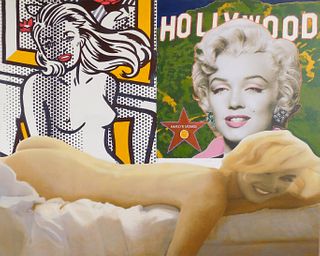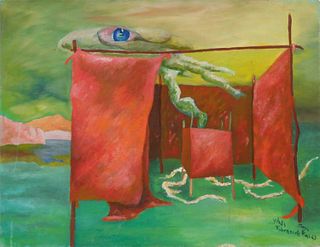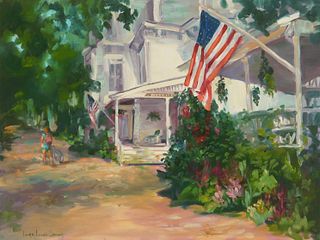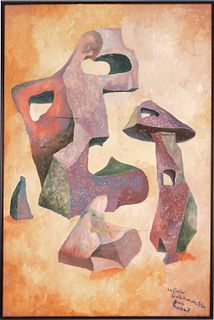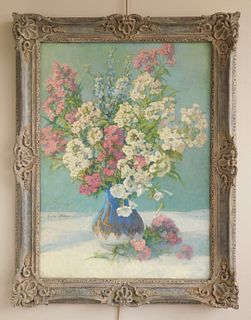GODOFREDO ORTEGA MUÑOZ (San Vicente de Alcántara, Badajoz, 1899 - Madrid, 1982). "Landscape, Retamas", 1963. Oil on panel. Signed in the lower right c
Lot 98
About Seller
Setdart Auction House
Carrer Aragó 346
Barcelona
Spain
Setdart Subastas was born in 2004 and is currently the first online art auction in Spain with solidity, prestige and reliability guaranteed by our more than 60,000 users. Setdart has a young, dynamic and enterprising team ready to successfully manage the purchase and sale of art works through custom...Read more
Estimate:
$20,000 - $25,000
Absentee vs Live bid
Two ways to bid:
- Leave a max absentee bid and the platform will bid on your behalf up to your maximum bid during the live auction.
- Bid live during the auction and your bids will be submitted real-time to the auctioneer.
Bid Increments
| Price | Bid Increment |
|---|---|
| $0 | $10 |
| $200 | $25 |
| $500 | $50 |
| $1,000 | $100 |
| $3,000 | $200 |
| $5,000 | $500 |
| $10,000 | $1,000 |
| $20,000 | $2,000 |
| $50,000 | $5,000 |
About Auction
By Setdart Auction House
Jun 17, 2021
Set Reminder
2021-06-17 06:15:00
2021-06-17 06:15:00
America/New_York
Bidsquare
Bidsquare : 19th & 20th Century Contemporary Art - Select Lots
https://www.bidsquare.com/auctions/setdart-auction-house/19th-20th-century-contemporary-art---select-lots-7081
Setdart Auction House sofia@setdart.com
Setdart Auction House sofia@setdart.com
- Lot Description
GODOFREDO ORTEGA MUÑOZ (San Vicente de Alcántara, Badajoz, 1899 - Madrid, 1982). "Landscape, Retamas", 1963. Oil on panel. Work reproduced in the reasoned catalog of the artist Volume II, nº 273, p. 367. Work exhibited in: “Forma y Landscape; Spanish painting of the 20th century ”: Jorge Juan Art Gallery, Madrid, 2001. Signed in the lower right corner. Measures: 33 x 41 cm; 42.5 x 50 cm (frame). Ocher, white, gray and black, make up this emblematic landscape that includes all the characteristics that distinguish the work of Godofredo Ortega; a stark landscape, realistic, but not academic, a solitary space that seeks to awaken the emotions of the viewer, etc.. This work reflects the great influence that his contact with the Vallecas School had on his painting, from which he took up landscape painting again, making the landscape the undisputed protagonist of his painting. Ortega Muñoz was one of the great creators of the contemporary Spanish landscape. He started in art when he was still a child, in a self-taught way, and despite his father's advice, in 1919, when he was twenty years old, he decided to move to Madrid to devote himself to painting. There he will dedicate himself from the first moment to making copies of the great masters in the Prado Museum and in the old Museum of Modern Art. He continued his self-taught training and began to paint outdoors in the surroundings of the Dehesa de la Villa, accompanied by other young artists such as the Filipino Fernando Amorsolo. A year later he decided to move to Paris, where he met his lifelong friend, the poet Gil Bel. In Paris he also got to know the work of Van Gogh, Gauguin and Cézanne, but at the same time he experienced the formal and ideological crisis that was developing in this interwar period, which would lead him to leave France to travel south, to Italy, where he would find in the masters of the past more authentic values of spirituality, simplicity and purity. Ortega Muñoz will travel through Italy from North to South between 1921 and 1922, and in Lago Maggiore he meets the English painter Edward Rowley Smart, with whom he will spend a short period of apprenticeship. With him Ortega Muñoz comes to the conclusion that, in the face of the apparent unreasonableness of contemporary art, it is necessary to return to nature and return to are the authenticity of spiritual truths and simple emotions. In 1926 he returned to Spain, where he was the protagonist of one of the founding excursions of the Vallecas School. Shortly afterwards, in 1927, he held his first exhibition at the Círculo Mercantil in Zaragoza. Then he leaves Spain again, and this time he travels through Central Europe, passing through Zurich, Brussels and several German cities. In 1928, in Worpswede, he comes into contact with a colony of artists of expressionist language, interested in landscapes and peasant life, as a reaction against the sophisticated artifices and refinements of the avant-garde. Notably influenced by his experience in Worpswede, Ortega Muñoz returns to France in 1928, and between 1930 and 1933 he continues to travel between Central Europe and Northern Italy; he finally arrives in Cairo in 1933, a date at which his skills as a portraitist have given him a comfortable way of life and important contacts. He exhibits in Alexandria with an enormous success, which will lead him to repeat the experience a year later, presenting an almost anthological exhibition in which his love for nature, the balance between color and mood, and that atmosphere of stillness and sadness characteristic of his language can already be appreciated. In 1935 he returns to Spain and the following year he presents an exhibition at the Círculo de Bellas Artes in Madrid. However, the civil war forced him to leave Spain; after the war he returned to his hometown, and finally reunited with the silent and lonely expanse of his landscape and with the close reality of that world that he felt as authentically his own.
- Shipping Info
-
In-house shipping available. Please inquire at admin@setdart.com.
-
- Buyer's Premium



 EUR
EUR CAD
CAD AUD
AUD GBP
GBP MXN
MXN HKD
HKD CNY
CNY MYR
MYR SEK
SEK SGD
SGD CHF
CHF THB
THB









